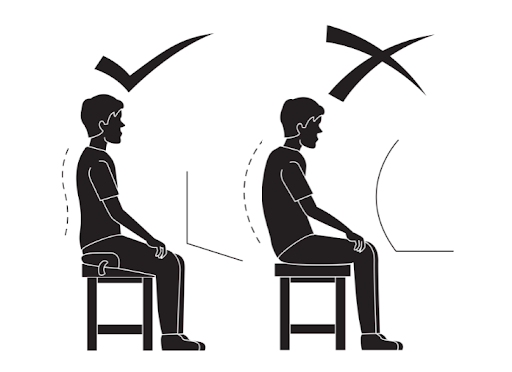What Is the Healthiest Way to Sit?
You know that feeling you get when you’re sitting and you start to feel uncomfortable? Perhaps the way that you’re sitting isn’t the best for your health. Considering most of us spend half our waking hours sitting down, if we don’t know the right techniques for how to do this properly then chances are good that not only will our condition worsen but also never get better.
As a general rule, for a healthy sitting posture, you should sit back as far as possible on the seat so that your back and buttocks can be supported well. The feet should be flat on the floor. Keep the seat as elevated as possible. Don’t cross your legs. Hips should be slightly higher than knees.
Not sitting in a healthy posture can really slow you down. Fortunately, there are things that I have learned as a chiropractor, ergonomic adviser, and ergonomic designer on how to deal with back issues and sitting posture! This article shares some research-based best practices for sitting that can relieve your symptoms of discomfort while seated.
Sit with the Correct Angles
You may think that you can just sit on a chair and get work done, but there are actually two important factors to consider when sitting. The first thing is your seat angle. You should make sure the front of your hips are at a higher angle relative to your knees or it might have adverse health effects for some people like increased pressure in their lumbar spine and lower extremities as well as poor circulation due to decreased blood flow from gravity pooling.
Following that, consider the angle at which your knees should be bent. Generally, it is recommended for your knees to lie directly over your ankles in order to alleviate nerve or circulation issues.
Seat Angle
Contrary to what you may have heard, people with back pain should actually not sit up straight. In fact, it is important for those who suffer from chronic back pains to recline their chairs as far down as 110 degrees so that the pressure on their spinal discs will be reduced by 35%.
In case of back pain, you should avoid stooping or slouching forward. In such a posture, your spinal cord is compressed and you are imposing substantial stress on your back, as shown in the chart.
In studies, the optimal recline angle for reducing disc pressure was 135 degrees, but using that position to work is simply unfeasible. Through the use of sEMG scans with various seating angles with my patients, I have found that most people feel comfortable in the 8-13 degree range or roughly 3-4 inches high hips compared to knees.
Knee Angle
You need to be aware of your sitting knee angle since it affects how your lower body positions.
- Never cross your legs while you sit.
- Maintain an angle of 90 to 110 degrees with your knees bent
- Be sure your two feet are planted firmly on the ground. You should keep your feet shoulder-width apart or more. By placing your feet this way, you will move from your hips and not from your spine.
- Placing your body in this type of neutral position will allow your back to rest and improve blood flow. Moving throughout the day is always essential, even if you have a perfect neutral posture. As a rule of thumb, the best posture is always one that moves.
Avoid Reaching Too Far
Another important tip for seating is to avoid overstretching the mid-back. This is a massive problem for most desk workers. Excessive stretching occurs most often when commonly used devices on your desk are too far away from you, such as the keyboard, mouse, and documents. You might also feel pressure on your back and shoulders while leaning forward since you’re bending from your spine and not from your hips.
Over time, your body will complacently adapt to this type of posture which ultimately leads to the breakdown of your joints and discs. So, to avoid this from happening it is best to organize your workspace so that items you use frequently are located within your reach.
Bring the keyboard and mouse as close as possible so that your elbows are relaxed at 90 – 110 degrees.
Workspace Ergonomics – Essentials Closer
You should also try to refrain from twisting your mid back while seated because this can lead to discomfort and tightness in the mid and lower back. If you need to reach for something, turn your office chair with your feet wide apart. This will, again, encourage movement from your hips which will avoid any potential mid or low back problems.
Use Armrests
Unsupported arms put all the burden on your neck, shoulders, and lower back. You should rest your arms on your chair’s armrests or the desk when typing or talking on the phone. When you sit in an office chair with supportive armrests, you can significantly reduce the weight on your spine.
At a very minimum, armrests should be at least height adjustable. A good armrest height is to be just a little higher than a desk. The reason being, if you have low armrests, you may develop a wrist-flexion injury. Therefore, you should level your wrists with your table.
Alternate Sitting and Standing
Sitting all day cannot possibly make you healthy! It’s important to stand every now and then. You’ll be more creative, less stressed, more focused – everything you need! The brain can generate much more ideas if it alternates between sitting and standing (preferably when walking). As a result, when people are working their hardest or doing important tasks such as writing essays, being in a new position during workdays allows them to always think fresh.
Getting Up From a Chair
It’s also crucial to know how to get up from a sitting position to avoid any back pain. Here’s how:
- Sit on the edge of your seat.
- For stability, get your feet a shoulders width or greater distance apart.
- To leverage your strength, leg one should be out in front and leg two a bit behind you.
- You can shift the weight to your legs by using your armrests as leverage.
- As you stand, lift your body up using your legs.
- Keep your back straight and avoid bending your waist.
Takeaway
Chances are that you spend a lot of time sitting down. If this is the case, then it’s important to know what kind of seat and posture will be best for your health. For some helpful guidance on ergonomic information, visit our blog!








